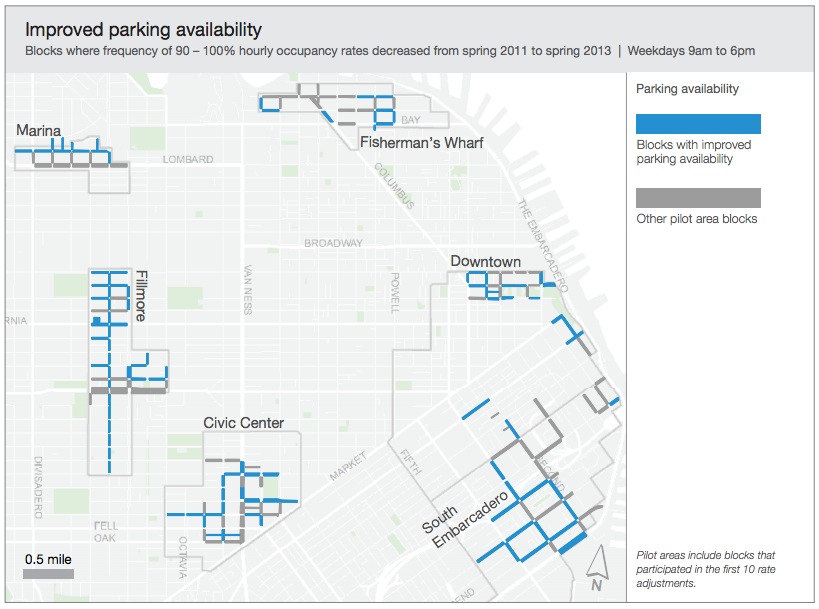SFpark
SAN FRANCISCO MUNICIPAL TRANSPORTATION AGENCY
SFMTA evaluation results
An overview of the benefits of the SFpark pilot project
The SFMTA evaluated the SFpark pilot project to see how effectively this approach to managing parking delivered the expected benefits. This section outlines what the SFMTA learned from this evaluation and provides transportation managers in other cities an overview of how parking management can help achieve their goals.
Rate change summary
Over the course of the SFpark pilot project, the SFMTA lowered the average hourly rate at meters by 11 cents from $2.69 to $2.58 and average hourly rates at SFpark garages by 42 cents from $3.45 to $3.03.
SFpark improved parking availability
While the SFpark pilot project had many goals, its primary focus was to make it easier to find a parking space. More precisely, the goal was to increase the amount of time that there was parking available on every block and improve the utilization of garages. Besides helping drivers, making it easier to park more of the time was expected to deliver other benefits (e.g., reducing circling, double parking, greenhouse gas emissions, etc.).
Even as the economy, population, and overall parking demand grew, parking availability improved dramatically in SFpark pilot areas. The amount of time that we achieved the target parking occupancy (60 to 80%) increased by 31% in pilot areas, compared to a 6% increase in control areas. On blocks where people paid the meter most of the time (in high payment compliance or “HP” pilot areas) where we would expect pricing to be most effective, achievement of the 60 to 80% target occupancy rate nearly doubled.
Even more importantly, the amount of time that blocks were too full to find parking decreased 16% in pilot areas while increasing 51% in control areas. In other words, SFpark made it easier for drivers to quickly find parking spaces. In areas where people pay at the meter most of the time, the impacts were even more notable, with a 45% decrease.
Secondary benefits
This section outlines the benefits of meeting occupancy
goals and making sure that there are open parking spaces.
It is easier for drivers to find a parking space. In SFpark
pilot areas, the amount of time most people reported that
it took to find a space decreased by 43%, compared to a 13%
decrease in control areas.
It is easier to pay and avoid citations. SFpark also sought
to create a parking experience that is simple, consistent,
easy to use, and respectful. The pilot project improved
the experience of parking by lengthening time limits and
making it much easier to pay. Drivers surveyed before and after SFpark were asked to rate their parking experience;
after SFpark, the likelihood of reporting that it was
somewhat or very easy to pay for parking increased in pilot
areas by 75%, or twice as much as in control areas that did
not receive new meters or longer time limits.
Making it easier for drivers to pay for parking also made
it easier to avoid parking tickets; in SFpark areas, the
SFMTA gave 23% fewer parking meter-related citations
per meter than before the pilot.
Greenhouse gas emissions decreased. Drivers generated 7 metric tons of greenhouse gas emissions per day looking for parking in pilot areas. This dropped by 30% by 2013, compared to a decrease of 6% in control areas
Peak period congestion decreased. SFpark encouraged
people to drive at non-peak times and improved parking
availability when it mattered most. On-street parking
availability improved by 22% during peak periods,
compared to 12% during off-peak. In SFpark garages,
morning peak entries rose 1% while off-peak entries rose
14%, and evening peak exits rose 3% while off-peak exits
rose 15% This suggests that SFpark helped to reduce
peak-period congestion, which makes the roads flow more
smoothly for drivers and transit.
Traffic volume decreased. In both pilot and control areas, where parking availability improved, traffic volume decreased by approximately 8%, compared to a 4.5% increase in areas where parking availability worsened.
Download full version (PDF): SFpark Pilot Project Evaluation
About SFpark
sfpark.org
SFMTA established SFpark to use new technologies and policies to improve parking in San Francisco. Reducing traffic by helping drivers find parking benefits everyone. More parking availability makes streets less congested and safer. Meters that accept credit and debit cards reduce frustration and parking citations. With SFpark, we can all circle less and live more.
About the San Francisco Municipal Transportation Agency
www.sfmta.com
The SFMTA plans, designs, builds, operates, regulates, and maintains one of the most diverse transportation networks in the world. In addition to the four modes of transportation (transit, walking, bicycling and driving, which includes private vehicles, taxis, carsharing, on-and off-street parking and commercial vehicles), the Agency directly oversees five transit modes (bus, trolley bus, light rail, historic streetcar, and cable car), in addition to overseeing paratransit service, which serves individuals unable to use fixed-route transit service.
Tags: 2013 Report Card on America's Infrastructure, CA, California, San Francisco, San Francisco Municipal Transportation Agency, SFMTA, SFPark







 RSS Feed
RSS Feed